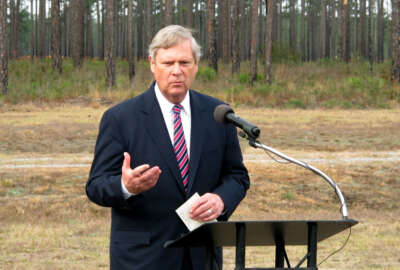
Agencies with top engagement sit high, but agencies at the bottom sit very low
The Partnership for Public Service's Best Places to Work rankings showed vast disparities between agencies with the highest and lowest employee engagement in 2016.
Agencies and subcomponents with the highest employee engagement vastly outscored their counterparts who sit at the very bottom of the 2016 Best Places to Work rankings.
The Partnership for Public Service and Deloitte grouped 69 agencies and subcomponents into five mission areas. They compared agencies’ engagement scores with other organizations who have similar missions and responsibilities.
Agencies were grouped by law enforcement/border protection, public health, infrastructure, national security and energy/environment missions. For all mission areas, the top ranking agency sat at least 20 points or more higher than the lowest ranking organization at the bottom of the list.
“We really wanted to focus on who are the federal workers who are completing the really important missions that Americans depend on?” Mallory Barg Bulman told the Federal Drive with Tom Temin. “The people who are focused on public health, the ones who are making the vaccines, making sure that our water system is safe, looking at law enforcement and border protection, national security, energy and infrastructure.”
This year, the Coast Guard sits at the top of the Best Places to Work rankings for the law enforcement/border patrol mission, with an engagement score of 71.1. The Secret Service is ranked last among 15 agencies in that mission for a score of 32.8.
| Top 5 Law Enforcement/Border Protection Agencies | ||||||||
| Agency | Score | |||||||
| Coast Guard (DHS) | 71.1 | |||||||
| Citizenship and Immigration Services (DHS) | 70.7 | |||||||
| U.S. Marshals Service (DoJ) | 69.4 | |||||||
| FBI (DoJ) (tie) | 68.7 | |||||||
| Drug Enforcement Administration (DoJ) (tie) | 68.7 | |||||||
| Federal Law Enforcement Training Center (DHS) (tie) | 68.7 | |||||||
| Criminal Division | 66.8 | |||||||
The top ranking agency for public health, the Centers for Disease Control and Prevention, sits more than 30 points higher than the agency with the lowest score, the Substance Abuse and Mental Health Services Administration.
Both subcomponents sit within the Health and Human Services Department.
| Top 5 Public Health Agencies | ||||||||
| Agency | Score | |||||||
| Centers for Disease Control and Prevention (HHS) | 72.9 | |||||||
| Centers for Medicare and Medicaid Services (HHS) (tie) | 70.4 | |||||||
| Food and Drug Administration (HHS) (tie) | 70.4 | |||||||
| National Institutes of Health (HHS) | 70.0 | |||||||
| Health Resources and Services Administration (HHS) | 68.1 | |||||||
| Food Safety and Inspection Service (USDA) | 68.0 | |||||||
The top and bottom agencies in the infrastructure mission have a 30-point difference. The Transportation Department’s Federal Highway Administration has a 77.9 engagement score, while the National Protection and Programs Directorate (NPPD), which sits last among 18 agencies, has a 46.1 score.
| Top 5 Infrastructure Agencies | ||||||||
| Agency | Score | |||||||
| Federal Highway Administration (DoT) | 77.9 | |||||||
| Office of Energy Projects (FERC) | 77.0 | |||||||
| National Institute of Standards and Technology (Commerce) | 72.1 | |||||||
| Martime Adminstration (DoT) | 69.5 | |||||||
| Bonneville Power Administration (DoE) | 68.4 | |||||||
With an engagement score of 67, the Intelligence Community sits at the top among seven agencies performing national security missions, and it’s ranked at the number three spot among large agencies in the Partnership’s general Best Places to Work report.
The Homeland Security Department sits at the bottom among national security agencies with a score of 45.8. DHS is also ranked last among large agencies overall, though the department made significant progress in 2016 to boost employee engagement and its score.
| Top 5 National Security Agencies | ||||||||
| Agency | Score | |||||||
| Intelligence Community | 67.0 | |||||||
| State Department | 66.8 | |||||||
| Navy Department | 60.7 | |||||||
| Office of the Secretary of Defense, Joint Staff, Defense Agencies | 59.8 | |||||||
| Air Force Department | 59.3 | |||||||
The Justice Department’s Environment and Natural Resources Division earned the highest engagement score of any of the 69 components. With engagement 85.9, that division also ranks as the number one agency for energy and the environment.
With engagement at just 53.8, the National Park Service sits at the bottom of 15 agencies in the energy and environment mission.
Congress in particular criticized NPS leaders for its toxic work culture, and whistleblowers spoke publicly of sexual harassment within the agency.
| Top 5 Energy/Environment Agencies | ||||||||
| Agency | Score | |||||||
| Environment and Natural Resources Division (DoJ) | 85.9 | |||||||
| Federal Energy Regulatory Commission | 79.0 | |||||||
| Nucler Regulatory Comission | 70.2 | |||||||
| U.S. Geological Survey (Interior) | 70.1 | |||||||
| U.S. Fish and Wildlife Service (Interior) | 68.0 | |||||||
Overall, federal employees said they were generally happier and more engaged in the workplace in 2016. For the second consecutive year, employee engagement rose last year, this time by 1.3 points for an overall score of 59.4. But agencies still largely lag behind the private sector, where engagement sits at about 77 points, according to the Partnership’s Best Places to Work report.
The Partnership grouped agencies by size to rank employee engagement scores at the end of 2016. But giving organizations a look at how they compare to other agencies that do similar work is often more telling, Bulman said.
“They think of themselves not only always by small agency, medium agency, large agency as we’ve done the Best Places to Work rankings,” she said. “What they really focus on is the work that they do.”
She also encouraged incoming political appointees to review at the Best Places to Work rankings and consider individual questions more closely, specifically one that examines their employees’ propensity to bring problems or challenges to their supervisor’s attention.
“If people don’t feel comfortable raising issues that arise, you going to be likely to be the next agency with the big issue that comes up,” Bulman said. “That really profoundly affects how the workforce feels.
Copyright © 2025 Federal News Network. All rights reserved. This website is not intended for users located within the European Economic Area.
Nicole Ogrysko is a reporter for Federal News Network focusing on the federal workforce and federal pay and benefits.
Follow @nogryskoWFED





